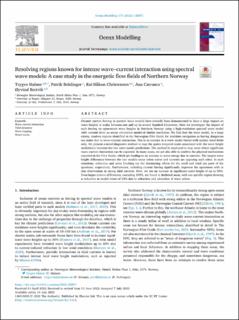| dc.contributor.author | Halsne, Trygve | |
| dc.contributor.author | Bohlinger, Patrik | |
| dc.contributor.author | Christensen, Kai Håkon | |
| dc.contributor.author | Carrasco, Ana | |
| dc.contributor.author | Breivik, Øyvind | |
| dc.date.accessioned | 2023-03-07T12:37:24Z | |
| dc.date.available | 2023-03-07T12:37:24Z | |
| dc.date.created | 2022-08-15T10:57:15Z | |
| dc.date.issued | 2022 | |
| dc.identifier.issn | 1463-5003 | |
| dc.identifier.uri | https://hdl.handle.net/11250/3056449 | |
| dc.description.abstract | Oceanic current forcing in spectral wave models have recently been demonstrated to have a large impact on wave heights at scales between one and up to several hundred kilometers. Here we investigate the impact of such forcing on open-ocean wave heights in Northern Norway using a high-resolution spectral wave model with currents from an ocean circulation model of similar resolution. We find that the wave model, to a large extent, resolves regions identified in the Norwegian Pilot Guide for maritime navigation as having dangerous sea states due to wave–current interaction. This is in contrast to a wave model forced with surface wind fields only. We present a novel diagnostic method to map the spatio-temporal scales associated with the wave height modulation between the two wave model predictions. The method is employed to map areas where significant wave–current interaction can be expected. In many cases, we are also able to confirm the physical mechanisms reported in the Pilot Guide, which are leading to an increase in wave energy due to currents. The largest wave height differences between the two models occur when waves and currents are opposing each other. In such situations, refraction and wave blocking are the dominating effects for the swell and wind sea parts of the spectrum, respectively. Furthermore, including current forcing significantly improves the agreement with in situ observations in strong tidal currents. Here, we see an increase in significant wave height of up to 50%. Even larger relative differences, exceeding 100%, are found in sheltered areas, with one specific region showing a reduction in model errors of 18% due to refraction and advection of wave action. | en_US |
| dc.language.iso | eng | en_US |
| dc.publisher | Elsevier | en_US |
| dc.rights | Navngivelse 4.0 Internasjonal | * |
| dc.rights.uri | http://creativecommons.org/licenses/by/4.0/deed.no | * |
| dc.title | Resolving regions known for intense wave–current interaction using spectral wave models: A case study in the energetic flow fields of Northern Norway | en_US |
| dc.type | Journal article | en_US |
| dc.type | Peer reviewed | en_US |
| dc.description.version | publishedVersion | en_US |
| dc.rights.holder | Copyright 2022 The Author(s) | en_US |
| dc.source.articlenumber | 102071 | en_US |
| cristin.ispublished | true | |
| cristin.fulltext | original | |
| cristin.qualitycode | 1 | |
| dc.identifier.doi | 10.1016/j.ocemod.2022.102071 | |
| dc.identifier.cristin | 2042934 | |
| dc.source.journal | Ocean Modelling | en_US |
| dc.relation.project | Norges forskningsråd: 300608 | en_US |
| dc.relation.project | Norges forskningsråd: 308796 | en_US |
| dc.identifier.citation | Ocean Modelling. 2022, 176, 102071. | en_US |
| dc.source.volume | 176 | en_US |

